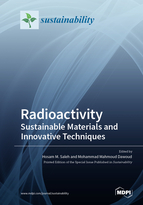Radioactivity: Sustainable Materials and Innovative Techniques
A special issue of Sustainability (ISSN 2071-1050). This special issue belongs to the section "Waste and Recycling".
Deadline for manuscript submissions: closed (31 January 2023) | Viewed by 22981
Special Issue Editors
Interests: radioactive and hazardous waste management; application of friendly environmental agents in radioactive waste management; development of matrices for immobilization of radioactive and hazardous wastes; application of organic and inorganic materials as additives to form cement composites as immobilizing matrices for hazardous wastes
Special Issues, Collections and Topics in MDPI journals
Special Issue Information
Dear Colleagues,
In the more than 30 years since the Chernobyl accident, which is equal to the half-life of the cesium-137 isotope, the scientific community has turned its focus to radioactive waste management and the development of sustainable solutions for nuclear pollution issues. Radioactive contaminants are among the most dangerous types of pollutants due to their sustained and destructive impact. However, the wide range of peaceful applications of nuclear technology in various fields, such as industrial, medicinal, agricultural, research, and others are growing, leading to more challenges associated with the sustainability of radioactive waste management to attain environmental and economic benefits. Therefore, it has become necessary to search for innovative, sustainable methods of radioactive waste management. Deep burial of contaminated material is not considered a final and sustainable solution and bequeaths severe problems to future generations. The most important of sustainable solutions is safe management of all products of nuclear industry processes, whether gas, liquid, or solid materials. This includes information about those isotopes, which are related to their radioactive intensity and the time when their danger ends, as well as clarifying aspects related to transportation and temporary and final storage. Radioactive waste management is one of the most important pillars of sustainability when dealing with these hazardous wastes. Management in the case of radionuclides with a long half-life reduces the period of radiotoxicity and ionization power of these radioactive wastes. Sustainable technologies also include treatment and stabilization of these wastes using green chemistry and natural adsorption mechanisms. Stabilization by low-cost and effective materials to immobilize and solidify these radioactive wastes and to isolate it from the surrounding environment is also one of the techniques for achieving sustainability. In this Special Issue, we would like to get different perspectives from diverse researchers with different scientific backgrounds in chemistry, physics, medicine, agriculture, engineering, and economics to understand the mechanism of interaction of these materials with the surrounding environment and how to treat, stabilize and dispose of radioactive waste in eco-friendly and innovative ways that meet the requirements of sustainability.
The rapid growth in the use of radioisotopes to meet the requirements of humankind, whether in energy, industry, agriculture or medicine, is inevitable. If this rapid growth is not followed by an evolution in scientific research and the development of sustainable tools for managing the generated radioactive waste resulting from these processes, an environmental disaster will occur in the next few years. Many countries produce thousands of tons of radioactive waste annually, and some of them contain highly dangerous radioactivity; hence, it has become irresponsible to future generations to make them face the danger of this waste. This Special Issue seeks contributions related to all parts of radioactive waste management via innovative and sustainable methods. All backgrounds and references are welcome as long as they contribute to inventing methods that can develop this sector. The topics include, but are not limited to, the handling, treatment, stabilization, and disposal of radioactive waste, whether that waste is liquid, solid, or gaseous.
Prof. Dr. Hosam M. Saleh
Dr. Mohammad Mahmoud Dawoud
Guest Editors
Manuscript Submission Information
Manuscripts should be submitted online at www.mdpi.com by registering and logging in to this website. Once you are registered, click here to go to the submission form. Manuscripts can be submitted until the deadline. All submissions that pass pre-check are peer-reviewed. Accepted papers will be published continuously in the journal (as soon as accepted) and will be listed together on the special issue website. Research articles, review articles as well as short communications are invited. For planned papers, a title and short abstract (about 100 words) can be sent to the Editorial Office for announcement on this website.
Submitted manuscripts should not have been published previously, nor be under consideration for publication elsewhere (except conference proceedings papers). All manuscripts are thoroughly refereed through a single-blind peer-review process. A guide for authors and other relevant information for submission of manuscripts is available on the Instructions for Authors page. Sustainability is an international peer-reviewed open access semimonthly journal published by MDPI.
Please visit the Instructions for Authors page before submitting a manuscript. The Article Processing Charge (APC) for publication in this open access journal is 2400 CHF (Swiss Francs). Submitted papers should be well formatted and use good English. Authors may use MDPI's English editing service prior to publication or during author revisions.
Keywords
- radioactive waste
- solid radioactive waste
- liquid radioactive waste
- radioactive waste management
- sustainability
- sustainable radioactive waste management
- radioactive waste remediation
- radioactive waste treatment, radioactive waste immobilization
- radioactive waste disposal, sustainable treatment of radioactive waste
- sustainable management techniques
- sustainable performance indicators
- sustainable materials in waste stabilization
- phytoremediation of radionuclides
- advanced techniques in nuclear waste management







